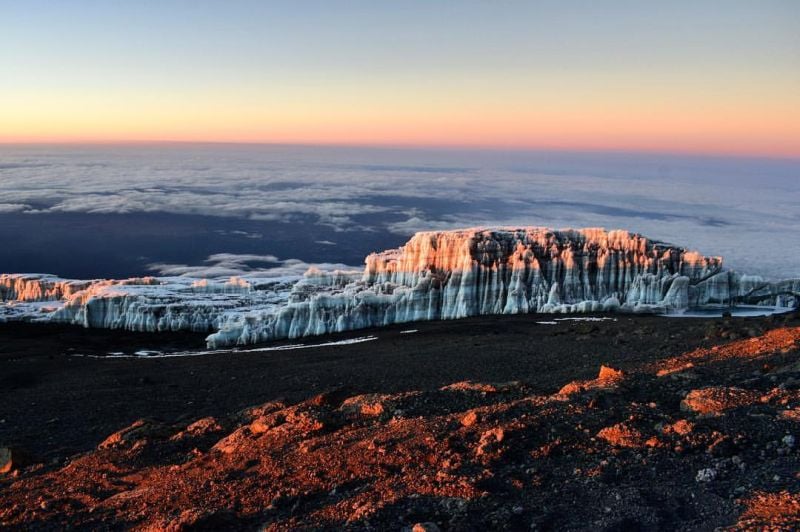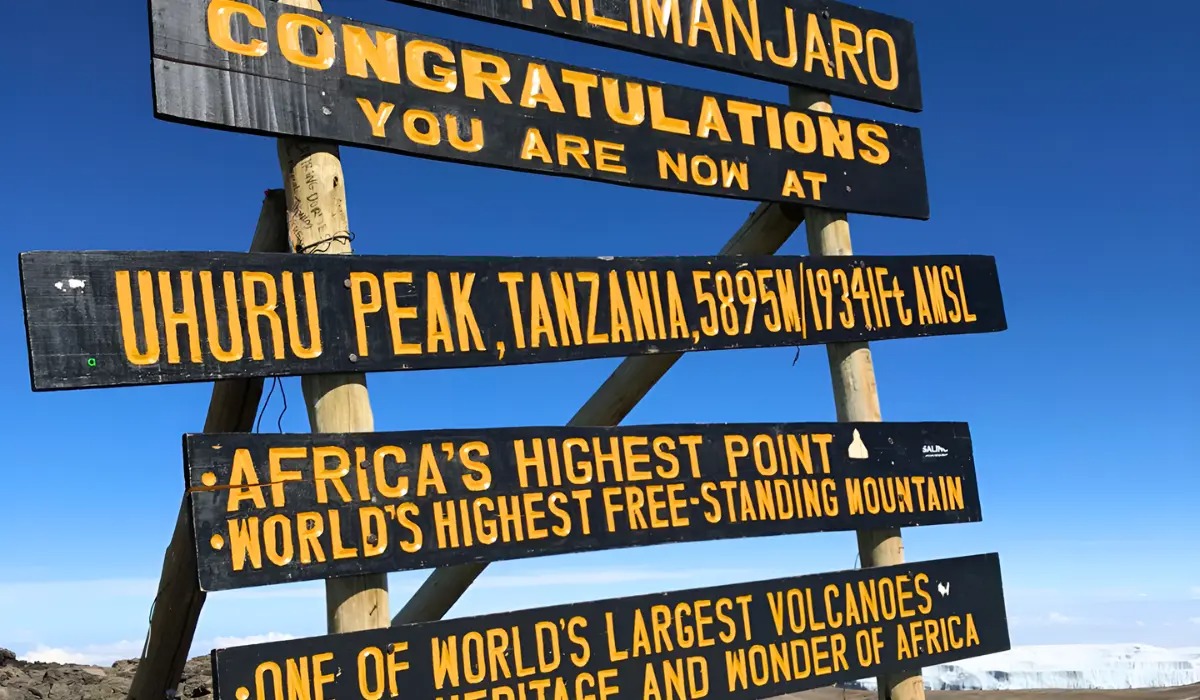Among the much-dreaded tales of climbing Kilimanjaro, the final step to get to Uhuru Peak—known as “summit night”—is no walk in the park, and some agree that it is the hardest part of climbing Kilimanjaro. This is when climbers leave their base camp in the middle of the night, aiming to stand on the peak by sunrise. Why do they start so late, and what makes this climb so tough? Let’s dive into the details of summit night and explore just how challenging it really is.
Imagine standing at the base of a giant mountain, surrounded by a quiet, starry night. The air is crisp, your breath visible in the glow of your headlamp. You’ve spent days hiking up Mount Kilimanjaro, passing through thick forests, rocky trails, and vast, empty stretches that feel like another planet. Now, you’re at a high camp—either Kibo Hut or Barafu Camp—ready for the biggest test of your journey: summit night. This isn’t just another day of trekking; it’s the moment that defines your Kilimanjaro experience.
Summit night begins in the early hours, usually around midnight, when most people would rather be asleep. Climbers bundle up in warm layers, sip a hot drink, and step into the darkness, guided only by small beams of light and the encouragement of their team. The goal? To reach Uhuru Peak, the top of Kilimanjaro, just as the sun peeks over the horizon. It’s a long, grueling climb followed by a descent back to a lower camp—all in one day. But there’s a method to this midnight madness, and it’s tied to both practicality and the magic of the mountain.
The trek to this point hasn’t been easy. Over several days, you’ve climbed higher and higher, adjusting to thinner air and changing scenery. You’ve felt the ache in your legs, the chill in the wind, and maybe even the first signs of altitude sickness—headaches or a queasy stomach. By the time you reach the base camp for summit night, you’re already tired, but the real challenge is still ahead. This final push is what separates Kilimanjaro from other hikes. It’s a test of endurance, willpower, and teamwork, all wrapped up in one unforgettable night.
Why midnight? For one, sleeping at high altitude is tough. The air up there has less oxygen, making it hard to relax or breathe deeply. Rather than lying awake, worrying about the climb, you get up and get moving. Another reason is the distance. From base camp to Uhuru Peak and back down to a rest camp, you’re covering a lot of ground—sometimes 13 to 16 hours of walking. Starting early lets you finish by afternoon. Plus, there’s no water near the summit. The high camps sit in a dry, rocky zone where streams don’t flow, so porters haul up every drop you need. The less time spent up there, the less water they have to carry.
Then there’s the reward: sunrise. After hours of climbing in the dark, you reach Stella Point, a key spot near the summit, just as the sky begins to glow. The colors—pink, orange, gold—spread across the snow and glaciers, lighting up the African plains below. From there, it’s a short trek to Uhuru Peak, where you stand on the “Roof of Africa” as the world wakes up. That moment, bathed in morning light, is what climbers chase. It’s beautiful, yes, but it comes at a cost.
The cold hits you hard on summit night. Temperatures drop below freezing, and the wind can howl, cutting through even the best gear. You’re climbing in pitch black, with only your headlamp to show the way, picking your steps over steep, rocky paths. Sleep? Forget it—you’ve barely rested, and your body feels it. The air gets thinner with every step, making breathing a chore, and the altitude can leave you dizzy or sick. The trail itself is no picnic either, with loose rocks—called scree—that slip under your boots. It’s a slow, exhausting slog, and your mind might start asking, “Why am I doing this?”
But there’s a flip side. Summit night isn’t just about struggle; it’s about triumph. When you reach Uhuru Peak, the exhaustion fades, replaced by a rush of joy. You’ve pushed your limits and won. The guides and porters who cheer you on become part of that victory, turning a solo dream into a shared success. It’s tough—maybe the toughest thing you’ll ever do—but that’s what makes it special.
Why Climb at Midnight?
Summit night is the heart of the Kilimanjaro climb. It’s a long, cold, steep journey that demands everything you’ve got. But when you stand on Uhuru Peak, watching the sun rise over a vast, wild landscape, you’ll understand why people take it on. It’s not just a climb; it’s a story you’ll carry forever.
Here’s why summit night starts in the dark:
- Sleep Is Hard Up High: At high altitudes, the thin air makes it tough to rest. Instead of staying awake in your tent, you start climbing.
- Long Day Ahead: You’ve got a big distance to cover—up to the summit and back down to a lower camp. A midnight start fits it all into one day.
- No Water Up Top: The area near the summit is dry, with no streams. Starting early means less time relying on carried water.
- Sunrise Magic: Getting to the top around sunrise lets you see the mountain and plains in gorgeous morning light.
What Happens on Summit Night?
Here’s the usual plan:
- 11 pm: Wake up, have a warm drink, and gear up.
- Midnight: Begin the climb with your headlamp lighting the way.
- Sunrise: Reach Stella Point (5,739 m) and watch the sun come up.
- 30 Minutes Later: Arrive at Uhuru Peak (5,895 m) for a quick celebration.
- Afternoon: Head back down to a lower camp, like Mweka or Marangu, to rest.
How Hard Is It?
To tackle summit night, which is the most difficult part of climbing the mountain, according to past climbers, you need to prepare. Physically, it means training your body with long hikes and stamina-building exercises. Mentally, it’s about steeling yourself for the hard moments and believing you can keep going. And practically, it’s leaning on your team—those experienced guides who know the mountain like their own backyard. Together, these pieces get you to the top.
Summit night is a real challenge. Here’s why:
- Freezing Cold: It’s icy, and the wind makes it feel even colder.
- Total Darkness: You’re climbing with just a small light, which can feel spooky and tricky.
- No Sleep: You’re running on fumes after little or no rest.
- Steep Climb: The path is sharp and covered with loose rocks that slip.
- Thin Air: Breathing is hard, and altitude sickness can hit—think headaches or nausea.
- Long Hours: The whole trip can take 13 to 16 hours, testing your stamina.
Tips to Get Ready
To make it through, try these:
- Mindset: Tell yourself you can do it, even when it’s rough.
- Training: Build your strength with lots of walking or hiking practice.
- Teamwork: Let your guides and porters lift your spirits and guide you.
Final Thoughts
Climbing to Uhuru Peak on summit night is super tough—cold, dark, and exhausting. But reaching the top as the sun rises, with all of Africa stretching out below, makes every hard step worth it. With preparation and support, you can conquer Kilimanjaro and come away with a memory that lasts a lifetime.


